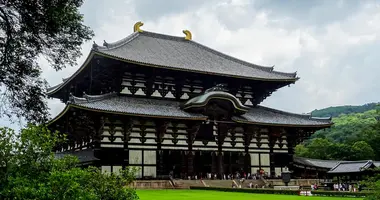Kashihara Jingu
- Published on : 09/02/2016
- by : Japan Experience
- Youtube
Kashihara Jingu (Kashihara Shrine) dates from 1889 and enshrines the mythical emperor Jinmu, the first emperor of japan.
- Kashihara Shrine History
- Kashihara Shrine Grounds
- Access - Getting To Kashihara Shrine
- Japan Temples & Shrines
Kashihara Jingu 橿原神宮
Kashihara Shrine, (Kashihara Jingu) is a large Shinto shrine located in Kashihara city on the western edge of the historic Asuka district of Nara Prefecture.
 Kashihara Shrine, Kashihara-shi, Nara Prefecture
Kashihara Shrine, Kashihara-shi, Nara Prefecture Kashihara Shrine, Kashihara-shi, Nara Prefecture
Kashihara Shrine, Kashihara-shi, Nara Prefecture
Kashihara Shrine History
The Kashihara Shrine is supposedly sited on the place that the mythical Emperor Jinmu (Jimmu), the "first emperor" of Japan, ascended to the throne.
In Japanese mythology Jinmu is believed to be a descendant of the sun goddess Amaterasu, who in turn is associated with the Japanese creation myth.
Jinmu's mythical reign has deep associations with Japanese nationalism and Meiji Period State Shinto. The enshrinement of emperors was a totally new thing that began after the fall of the Bakufu in 1868. From Meiji on it was the imperial system and the emperor that was to be the basis of the new nation.
Kashihara Jingu dates from 1889 and the Meiji Period of Japanese history. The spacious and pleasant shrine is located in a large, preserved area of forest and small lakes just south of Mount Unebiyama.
To the north lies the Emperor Jinmu Mausoleum and within close proximity are the mausoleums of Emperor Suizei, Emperor Annei, and Emperor Itoku - the second, third and fourth Japanese emperors - all of them mythical according to historians.
The creation of Kashihara Jingu and the mausoleums of the first four mythical Japanese emperors in the heart of what was once the first centralizing state in Japanese history - Yamato in Asuka - was part of the Meiji government's policy of establishing the foundations of a nationalist narrative to rally and indoctrinate its populace, who, during the preceding Edo Period had been more focused on local, clan allegiances centered on their han (domain) and daimyo (feudal lord).
With the defeat of the Tokugawa shogunate in 1868 and the Meiji Emperor's new centrality as head of state, fresh national symbols were needed to reinforce the legitimacy of "imperial rule". Kashihara Jingu was thus an important statement in Meiji era state building and enshrines Emperor Jinmu and his consort Hime-tatara-Isuzu-Hime.

Kashihara Shrine sake barrels, Nara Prefecture Kashihara Shrine, Nara Prefecture
Kashihara Shrine, Nara Prefecture
Kashihara Shrine Grounds
The Main Hall and Kagura-den were relocated here according to the wishes of Emperor Meiji from the Imperial Palace (Gosho) in Kyoto and are the two most important structures at the shrine.
Visitors enter through a huge wooden torii gate and proceed along an avenue flanked by wooden lanterns donated by businesses and private individuals towards a second large torii. At the end of this gravel walkway is a large, duck-filled lake to the left and to the right, the entrance to the main shrine precincts.
This long approach to the shrine called Omote-sando is comparable in length, though slightly shorter, to those at Meiji Shrine in Tokyo and Ise Jingu in Mie Prefecture.
Just to the left of the main entrance torii (gate) is a small museum with displays of swords, manuscripts, pottery, paintings, calligraphy and other shrine treasures.
 Kashihara Shrine, Nara Prefecture
Kashihara Shrine, Nara Prefecture
Kashihara Shrine (kashiharajingu.or.jp)
934 Kume-cho, Kashihara-shi
Nara Prefecture
634-0102
Tel: 0744 22 3271
Hours: 6.30 am-5 pm
Admission: Free to enter the shrine grounds; 300 yen for the Treasure House.
Access - how to get to Kashihara Shrine
Kashihara Jingu is a short walk or rental cycle ride from Kashiharajingu-mae Station.
Kashiharajingu-mae Station is on the Kintetsu Line from Yamato-Saidaiji Station and Kintetsu Nara Station. These stations can also be reached from Abenobashi Station in Osaka.
Okadera Station and Asuka Station are the next two stations south on the Kintetsu Yoshino Line.
The Imai-cho cluster of historic Edo and Meiji Period buildings is also within easy reach of Kashihara Jingu about 1km to the north at the crossroads of national Highways 165 and 24. Bicycle rental from the station allows access to Okadera Temple to the east.

















